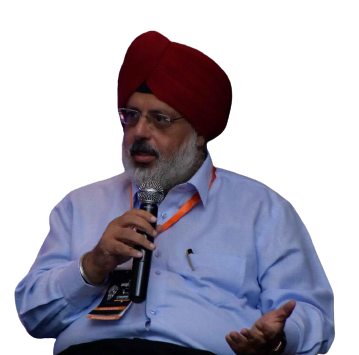By K. S Ahluwalia
Measuring what matters begins with the question: what is the most important for the next 3, 6, 9, 12, months. Successful organizations focus on the handful of initiatives that make a real difference, deferring less urgent ones. Their leaders commit to those choices, in word and deed. By standing firmly behind a few top-line OKR’s, they give their teams a compass and base line for assessments. Wrong decisions can be corrected once results begin to roll in. Non –decisions or hastily abandoned ones teach us nothing.
- What are our main priorities for the coming period?
- Where should people concentrate their efforts?
While pairing back a list of goals is invariably a challenge, it’s still well worth the effort. With a select set of OKR’s, we need to highlight a few things – the vital ones – that must get done and planned on time.

In the beginning……
For organization – level OKR’s the buck stops with senior leadership. They personally must commit to the process.
- Where do they begin?
- How do they decide what truly matters most.
Google turned it into a mission statement ‘organize the world’s information and make it universally accessible and useful’. Android, Google Earth, Chrome and new and improved You tube search engine- these products and dozens more, share a common linage. In each case, the impetus for development came from the founders and executive team, who made plain their focus and commitment through objectives and key results.
When an OKR rises from the top line’ all eyes in the company are on your team’ that’s a lot of eyes. One has no idea of doing it in a specific time slot, yet all understand that owning a company level OKR demonstrate that one’s work took priority. Regardless of how leaders chose a company’s top – line goals, they also need goals of their own. Just as vales cannot be transmitted by memos, structured goal setting won’t take root by fiat. OKR’s require a public commitment by leadership, in word and deed.
When one hears CEO saying that ‘all my goals are team goals, it’s a red flag’. When you are the CEO/founder, you got to say’ that is what we are doing’, and then you need to model it. Because you don’t model it, no one is going to do it.
Communicate with clarity
Top line goals need to clearly understand throughout the corporation. Yet by their own admission, 2 out of 3 companies fail to communicate these goals consistently. One of the main reasons why performance lags is that not even half of the managers don’t remember them.
Leaders must get across the why as well as the what. Their people need more than the milestones for motivation. They are thirsting for meaning, to understand how their goals relate to the mission. Remember when you are tired of saying it; people are starting to hear it.
Key results: Care and feeding.
Objective and key results are yin and yang of goal setting- principle and practice, vision and execution.
- Objectives are the stuff of inspiration and far horizons.
- Key results are more earth- bound and metric- driven- typically include hard numbers, for one or more gauges: revenue growth, active users, quality, safety, market share, customer engagement.
A manager must be able to measure- performance and results against the goal.
- Key results are the levers you pull, the marks you hit to achieve the goal.
- If an objective is well framed- 3-5 OKR’s will usually be adequate to reach it. Too many can dilute focus and obscure progress. Besides, each key result should be a challenge in its own right. If you are certain you are going to nail it, you’d probably not pushing hard enough.
What, How and When.
OKR’s are a shock to the established order; hence it may make sense to ease into them. The desired practice is may be parallel, dual cadence, with short horizon OKR’s- from the here and now, supporting annual OKR’s and long term strategies. Keep in mind, though, that’s it’s the shorter term goals that drive actual work. They keep annual plans honest and executed.
Clear cut time frames intensify our focus and commitment; nothing moves us forward like a dead line. To win in the global market place, organizations need to be more nimble than ever before. Quarterly OKR cadence is best suited to keep pace with today’s fast changing markets as it curbs procrastination. Remember for the feedback to be effective, it must be received very soon, after the activity, measuring occurs. Accordingly, an OKR system should set objectives for a relatively short period. For example, if we plan on yearly basis, the corresponding OKR time should be at least as often as quarterly or perhaps even monthly.
There is no legion to this protocol, no size fits all. A monthly cycle could do that trick for an early stage company still finding its product – market fit. The best OKR cadence is the one that fits the context and culture of your business.
Pairing Key Results
The history of the infamous Ford Pinto, shows the hazards of one dimensional OKRs. In 1971, after bleeding market share to more fuel efficient models from Germany and Japan, Ford countered it with Pinto – a mid size compact car. To meet CEO Iacocca’s aggressive demands, product managers skipped over safety checks in planning and development.
The Pinto’s in – house green book cited three product objectives
- True sub compact- size, weight.
- Low cost of ownership – initial price, fuel consumption, reliability, serviceability.
- Clear product superiority – appearance, comfort, features, ride, handling, performance.
Safety was nowhere in the list. Ford had to recall 1.5 million Pintos- the largest in the automotive industry. The company’s balance sheet and reputation took a justified beating. Looking back, Ford didn’t lack objectives or key results. But its goal setting process was fatally flawed. The specifics challenging goals were met – speed to market, fuel efficient, and cost, at the expense of other important features that were not specified – safety, ethical behaviour, and company’s reputation.
Frago reeled from a consumer banking scandal that stemmed from ruthless, one dimensional sales targets. Branch managers felt pressurised to open millions of fraudulent accounts that customers neither wanted nor needed resulting in damaging Fargo’s brand, beyond repair.
More ambitious the OKR, the greater the risk of overlooking a vital criterion. To safe guard quality, while pushing for quantitative deliverables, one solution is to pair key results – to measure both effect and counter effect- when key results focus on output. As in accounts the number of vouchers processed should be paired with the number of errors found wither by auditing or by our suppliers.
Result paired for Quantity and Quality
| Quantity Goal | Quality Goal | Result |
| 3 new features | Fewer than 5 bugs per feature in quality assurance testing | Developers will write cleaner code |
| $ 50 million in Q1 sales | S10 million in maintenance contracts | Sustained attention by sales professionals will increase customer success and satisfaction rates. |
| 10 sales Calls | 2 new orders | Lead quality time will improve to meet the new order threshold requirement. |
The perfect and the good.
Google CEO Sundar Pichai, once said, that his team often ‘agonised’ over their goal setting process. There are single OKR’ lines on which you can spend 1.5 hours thinking, to make sure that we are focused on doing something better for the user. That’s part of the territory –paraphrasing it – don’t allow the perfect to be enemy of the good. Remember that an OKR can be modified or even scrapped at any point in this cycle. Sometimes the right key result surface weeks or months after a goal is put into play. OKR’s are inherently work in progress, not commandments etched in stone. Done is always better than the perfect.
A few goal setting rules:
- Key results should be succinct, specific and measurable.
- A mix of outputs and inputs is helpful.
- Completion of all key results must result in attainment of the objective. If not, it’s not an OKR.
An OKR quality Continuum
| Weak | Average | Strong |
| Objective : win the Indy 500 | Objective : Win the Indy 500 | Objective : Win the Indy 500 |
| Key Result : Increase lap speed | Key Result : Increase average lap speed by 2% | Key Result : Increase average lap speed by 2% |
| Key Result : Reduce pit stop time | Key Result : Reduce average pit stop time by 1 second | Key Result : Test at wind tunnel 10 times |
| Key Result : Reduce average pit stop time by 1 second | ||
| Key Result: Practice pit stops 1 hour per day. |
Less is more
Innovation means saying no to one 1000 things. Ideally the number of quarterly OKRs range between 3-5. Too many objectives blur our focus on what count s or distract us in chasing the next shiny thing. We need putting too much down. Selective gaol setting is the first line of defence against getting over extended. Once contributors have been consulted with their managers and committed to their OKR’s for the quarter, any add on objectives or key results must fit into the established agenda.
- How does the new goal stack up against my existing ones?
- Should something be dropped t make room for this new commitment.
In a high functioning OKR system, top – down mandates to just do more are obsolete. Orders give way to questions, and to one in particular – what matters most. When it comes to goals setting, less is more. Each time you make a commitment, you forfeit your chance to commit something else. This, of course if an inevitable, inescapable consequence of allocating any finite resource. People who can plan to have guts, honesty, and discipline to drop projects as well as to initiate them, to shake their heads – no, as well as to smile yes. We must realize – and act on the realisation – that if we try to focus on everything we focus on nothing.
Top line objectives must be significant. OKR’s are neither a catchall wish list nor the sum of team’s mundane tasks. They are a set of stringently curated goals that merit special attention and will move people forward in the here and now. They link to a larger purpose we are expected to deliver around.
The art of management lies in the capacity to select from the many activities of seemingly comparable significance the 1, 3, 5 that provide leverage well beyond the others and concentrate on them.
Wining organizations need to out more wood behind fewer arrows. That, in very few and focused words, is the essence of focus and commit to priorities.
(K. S Ahluwalia)
February 26, 2020








